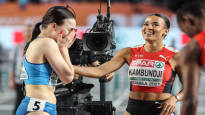Reetta Hurske rose from the shadows to become a true star of Finnish hurdles, writes Urheilu’s Joel Sippola.
5.3. 20:10•Updated 5.3. 21:45
Women’s hurdles has long been one of the most interesting athletics sports in Finland. There has been talk of a help boom.
It is not wrong to say that it was, at least for a while, the number one sport in Finnish athletics. It is still the closing sport of many domestic GP races, even though all of our top riders sometimes shine in their absences.
In addition to sporting aspects, the popularity has been based Annimari Kortene, Nooralotta Nezirin and Lotta Haralan to such persons. The public, media and sponsors have liked it.
Based on the attention the sport has received, someone who follows less athletics could have easily thought that women’s high-speed fences have become a big success in adult competitions. Before the 60-meter hurdles final at the EC Halls in Istanbul, however, no medals had come.
Of course, it has been close. In 2019 and 2021 Reetta Hurske and Neziri experienced a stinging fourth place.
However, it doesn’t count close. Finland’s haul of four medals at the European Championships in Munich last summer showed that a large audience is thirsty for medals.
Korte, Neziri, Harala and Hurske have been the best in Finland for a long time. After Hurskee, 27, there hasn’t been a new international-level Finnish shortstop for a while. When summer approaches, we always talk about the most valuable competition summer of all time.
However, that boom has not materialized in the past in medals or even in actual 100-meter final places. Tough mutual struggles and runs of just under 13 seconds are nice things, but you need freshness. A new development leap is required as a collective.
That’s why Reetta Hurskee’s 60-meter European championship has a very special weight. The Finnish female speed skater is finally capable of medal success at the prestigious competition level. It serves as a brand new example for others.
Success in the value competition brings meaning
The fact that it is Hurske who brings Finland the sport’s first medal in women’s is surprising.
Born in 1995, the Tampere sailor was a final-level athlete in the prestigious youth competitions. Still, he was never a junior who would have grabbed headlines with capital letters.
The athlete who was watched closely for a long time in the high-speed fences was Nooralotta Neziri, who had a reputation for great top promise. He won the European youth championship and was third in the under-23 European Championship.
Neziri has been a big trendsetter for the sport, breaking barriers. She was the first Finnish woman who was able to break the 13-second limit, which is considered to be a kind of borderline. Neziri has also been in the 60 meter hurdles final four times.
In recent years, Hurske was the runner who got less attention out of the three runners under 13 seconds in Finland. Sometimes Harala has also been a more interesting name. On the other hand, being off the radar suits Hurskee perfectly.
Now it produces value competition success. In the 60-meter hurdles, Hurske is an international star who has never been seen in Finnish women’s hurdles before.
by Nadine Visser and Cyrena Samba-Mayelan beating value competition winners like you is mind-blowing. They are the absolute cream of the crop also outdoors, so anything is possible in the 100-meter fences as well.
Hurske turns 28 in the spring. He still has several good years to achieve more indoor success. Next winter, we can even talk about a World Cup medal.
60 meters is a more favorable distance for Hurskee, who is known as a good runner, than 100 meters running on outdoor tracks, but this indoor season creates great expectations for the summer as well. There is an opportunity to take a big notch off the four-year-old record time of 12.78. At the same time, SE 12.72 hits.
Hurske is the one of the current domestic hurdlers who has the best conditions to also take the 100-meter hurdles European Championship medal. It is unlikely that Neziri and Harala, who have suffered from injuries in recent years, would be able to achieve a full hit like the younger Hurskee in prestigious competitions.
And it is precisely the success in the value competition that makes Hurskee the hardest and most significant Finnish sprinter of his era.
